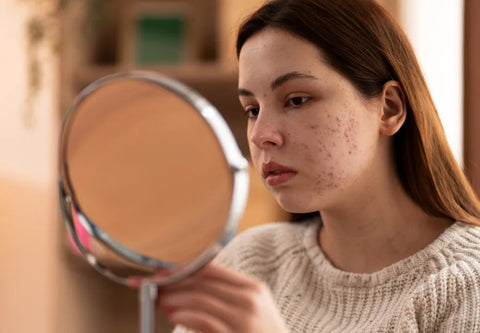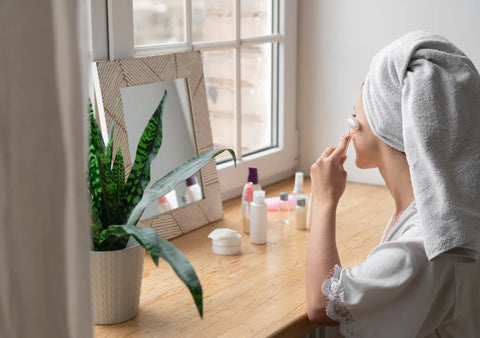ما هو حب الشباب؟
حب الشباب ليس مجرد مشكلة مراهقين - إنه حالة جلدية حقيقية تؤثر على ملايين الأشخاص عبر جميع الفئات العمرية. اعتبر حب الشباب كطريقة بشرتك في قول: "مرحبًا، هناك شيء غير صحيح هنا!" يظهر في شكل بثور، ورؤوس سوداء، ورؤوس بيضاء، وأحيانًا تلك الكيسات العميقة المؤلمة. غالبًا ما يظهر خلال فترة المراهقة عندما تعمل الغدد الدهنية بشكل مفرط، لكنه لا يتوقف دائمًا عند هذا الحد.
لماذا يحدث حب الشباب؟
بشرتك مغطاة بمسام صغيرة، وكل واحدة منها متصلة بغدة دهنية. تنتج هذه الغدد الزهم، وهو في الأساس مرطب طبيعي لبشرتك. عندما يكون هناك الكثير منه، أو إذا كانت خلايا الجلد الميتة تسد مسامك، يمكن أن تتسلل البكتيريا وتسبب تلك البثور المزعجة.
متى يبدأ حب الشباب عادة؟
يبدأ معظم الناس في ملاحظة حب الشباب خلال فترة المراهقة. هذا هو الوقت الذي تبدأ فيه الهرمونات في العمل، وخاصة الأندروجينات، التي تخبر الغدد الدهنية بإنتاج المزيد من الزهم. لكن حب الشباب لا يختفي دائمًا بعد المدرسة الثانوية - العديد من البالغين يتعاملون معه أيضًا.
هل حب الشباب خطير؟
حب الشباب ليس خطيرًا من الناحية المهددة للحياة، لكنه يمكن أن يؤثر بالتأكيد على ثقتك بنفسك، وفي الحالات الشديدة، يترك ندوبًا. لهذا السبب من المهم علاجه مبكرًا وبشكل صحيح.
أنواع آفات حب الشباب
دعنا نفصل الأمر - حب الشباب ليس مجرد "شيء واحد". إنه يأتي في عدة أشكال، كل منها له مظهره وإحساسه الخاص.
الكوميدونات
هذه هي أنواع حب الشباب الأساسية وغير الالتهابية.
رؤوس بيضاء مغلقة (رؤوس بيضاء)
هذه نتوءات صغيرة ومستديرة تحت الجلد مع قمة بيضاء. تبقى مغلقة وعادة لا تؤلم.
رؤوس سوداء مفتوحة (رؤوس سوداء)
على عكس الاعتقاد الشائع، الرؤوس السوداء ليست متسخة. اللون الداكن هو مجرد زهم مكشوف للهواء. إنها مسام مفتوحة مليئة بالزيت والجلد الميت.
حب الشباب الالتهابي
هذا النوع يصبح أحمر ومتورم وأحيانًا مؤلم.
حبوب
نتوءات صغيرة وردية تشعر بالحنان عند لمسها.
بثرات
حبوب حمراء تأخذها إلى مستوى آخر - مع مركز مليء بالصديد الأبيض أو الأصفر وقاعدة حمراء. بشكل أساسي، هي حبة الشباب الكلاسيكية.
عُقَد
هذه عميقة وصلبة ومؤلمة. تتشكل تحت الجلد وتستغرق وقتًا أطول للشفاء.
كيسات
آفات كبيرة مليئة بالصديد ومؤلمة يمكن أن تؤدي إلى تشوهات. إذا كنت قد عانيت من واحدة، فأنت تعرف - إنها ليست مزحة.
أسباب شائعة لحب الشباب
لا يوجد سبب واحد فقط وراء حب الشباب. عادة ما يكون مزيجًا من ما يلي:
زيادة إنتاج الزهم
الكثير من الزيت = مسام مسدودة.
بصيلات الشعر المسدودة
خلايا الجلد الميتة التي لا تتساقط بشكل صحيح يمكن أن تسد المسام وتحبس الزيت.
نمو البكتيريا (P. acnes)
هذه البكتيريا تحب أن تزدهر في المسام المسدودة، مما يسبب الالتهاب وظهور البثور.
المحفزات الهرمونية
سن البلوغ، الدورة الشهرية، الحمل، أو التوتر - جميعها تؤثر على الهرمونات ويمكن أن تؤدي إلى حب الشباب.
عوامل الخطر الأخرى
الأطعمة الحارة، منتجات الألبان، مستحضرات التجميل الدهنية، التوتر، أو حتى عدم غسل غطاء الوسادة بشكل كافٍ!
كيف يؤثر حب الشباب على مناطق مختلفة من الجسم
حب الشباب في الوجه
الجبهة، الخدين، الذقن - أيًا كان. هذا هو الأكثر وضوحًا وشيوعًا.
حب الشباب في الظهر والكتفين
المعروفة باسم "باكني"، وغالبًا ما تسببها العرق، والاحتكاك، والملابس الضيقة.
حب الشباب في الصدر
مشابهة لحب الشباب في الظهر، العرق والمسامات المسدودة هما السبب المعتاد.
البثور في الرقبة وخط الفك
غالبًا ما تكون هرمونية، خاصة عند البالغين.
فهم منتجات علاج حب الشباب
كيف تعمل؟
تستهدف معظم منتجات حب الشباب الزيت الزائد، والبكتيريا، أو المسام المسدودة. بعضها يقشر، بينما يهدئ البعض الآخر الالتهاب أو يقتل البكتيريا.
ما النتائج التي يمكن توقعها؟
لن ترى معجزات بين عشية وضحاها - الاستخدام المستمر على مدى أسابيع هو ما يجلب التغيير الحقيقي.
المكونات الرئيسية في منتجات العناية بالبشرة ضد حب الشباب
إليك بعض المكونات الشائعة في تركيبات مكافحة حب الشباب:
حمض الساليسيليك
حمض بيتا هيدروكسي (BHA) الذي يقشر داخل المسام، ويزيل الرؤوس السوداء، ويهدئ الالتهاب.
حمض أولينوليك
يقاتل البشرة الدهنية عن طريق تقليل إنتاج الزهم وتهدئة الالتهاب.
حمض نورديدروغوايا ريتك (NDGA)
مضاد أكسدة نباتي يقلل من تراكم الخلايا ويهدئ البشرة المتهيجة.
زيت الأفوكادو
غني بالأحماض الدهنية والفيتامينات، يساعد على الترطيب دون انسداد المسام.
بانثينول
المعروف أيضًا باسم برو-فيتامين B5 - يرطب وينعم البشرة.
ألانطوين
يعزز الشفاء، يقلل من التهيج، ويجعل البشرة تشعر بالنعومة.
بيسابولول
مكون مهدئ من البابونج يدعم تجديد البشرة.
اختيار العلاج المناسب لحب الشباب
حب الشباب الخفيف
ابحث عن منظفات لطيفة تحتوي على حمض الساليسيليك أو بيروكسيد البنزيل.
حب الشباب المعتدل
جرّب علاجات موضعية أقوى أو مستحضرات موصوفة تحتوي على الريتينويدات.
حب الشباب الشديد
قد تحتاج إلى مضادات حيوية، أدوية فموية، أو زيارة طبيب الجلدية.
علاجات طبيعية ونصائح للعناية بالبشرة
روتين العناية بالبشرة اللطيف
اغسل مرتين يومياً بمنظف لطيف. لا تفرك - بشرتك ليست سطح مطبخ!
مكونات منزلية تساعد
زيت شجرة الشاي، مستخلص الشاي الأخضر، والألوة فيرا شائعة لسبب - فهي مهدئة ومضادة للبكتيريا.
أساطير حول حب الشباب يجب أن تتجاهلها
-
حب الشباب ناتج عن بشرة متسخة - خطأ!
-
تحتاج إلى فركه بعيداً - لا.
-
فقط المراهقين يحصلون على حب الشباب - البالغون، نراكم أيضاً.
-
الشوكولاتة تسبب حب الشباب - لا دليل قاطع، آسف لعشاق الشوكولاتة.
كيف تمنع ظهور البثور في المستقبل
-
اغسل وجهك بانتظام
-
تجنب لمس وجهك
-
احتفظ بشعرك ومفروشاتك نظيفة
-
استخدم منتجات العناية بالبشرة غير المسببة للرؤوس السوداء
متى يجب عليك رؤية طبيب الجلدية؟
إذا لم تنجح أي شيء بعد بضعة أشهر أو كانت حب الشباب مؤلمة وتؤثر على ثقتك بنفسك، اذهب لرؤية متخصص. لا عيب في طلب المساعدة!
الخاتمة
قد تكون حب الشباب شائعة، لكن هذا لا يعني أنه يجب عليك التعايش معها. مع المعرفة الصحيحة، وعادات العناية بالبشرة، والعلاجات، فإن الحصول على بشرة صافية هو بالتأكيد في متناول اليد. من فهم الأسباب الجذرية إلى اختيار المكونات الصحيحة، أنت الآن مسلح بكل ما تحتاجه لمواجهة البثور.
الأسئلة الشائعة
1. ما هي الأطعمة التي تحفز حب الشباب؟
الأطعمة ذات المؤشر الجلايسيمي العالي مثل الخبز الأبيض، والوجبات الخفيفة السكرية، وأحيانًا منتجات الألبان يمكن أن تكون مرتبطة بحب الشباب.
2. هل يمكن أن يسبب التوتر ظهور البثور؟
نعم! يزيد التوتر من مستويات الكورتيزول، مما يمكن أن يحفز إنتاج المزيد من الزيوت.
3. هل من المقبول عصر البثور؟
مغري، لكن لا. يمكن أن يؤدي إلى ندبات وعدوى.
4. كم من الوقت يستغرق عمل منتجات حب الشباب؟
عادةً، 4-8 أسابيع من الاستخدام المستمر لرؤية تحسينات ملحوظة.
5. هل يمكن أن تختفي حب الشباب من تلقاء نفسها؟
قد تختفي حب الشباب الخفيف، لكن الحالات المتوسطة إلى الشديدة غالبًا ما تحتاج إلى علاج.









تعليقات (0)
لا توجد تعليقات على هذا المقال. كن أول من يترك رسالة!